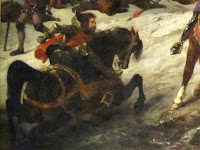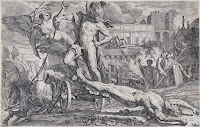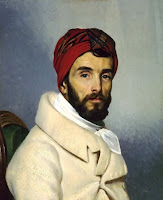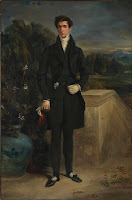 |
| The Battle of Nancy by Eugène Delacroix (1831) |
The Battle of Nancy and the Death of Charles the Bold
 |
| The Battle of Nancy Detail of Charles the Bold |
 |
| The Battle of Nancy Detail of Claude de Bauzemont |
 |
| Charles the Bold found after the Battle of Nancy by Auguste Feyen-Perrin (1865) |
Delacroix’s the Battle of Nancy Analysis
 |
| Achilles Dragging the Body of Hector by Pietro Testa (1612-1650) |
 |
| Portrait of Charles X by François Gérard (1825) |
 |
| Self-Portrait by Pierre-Narcisse Guérin (1774) |
 |
| Henri César Auguste Schwiter by Eugène Delacroix (1828-1830) |
The painting technique chiaroscuro means the effective use
of light and dark together to create more realistic figures. Delacroix’s
adaption of light dark painting and with the help of the inspiration of Peter Paul Rubens paintings containing vivid colors for the purpose of obtaining dynamism,
may be seen as a watershed point for the romantic artist to create his own
disegno and artstyle. The Venus of Urbino by Titian is a great example to examine the light and dark technique and to reveal how the famous French painter was influenced by Baroque Art.
The Battle of Nancy Painting in Historical Context
 |
| Portrait of Mary the Rich by Michael Pacher (1490) |
The Battle of Nancy Legacy and Facts
 |
| The Barque of Dante by Eugène Delacroix (1822) |
The Battle of Nancy by Eugène Delacroix
 Reviewed by Articonog
on
February 03, 2022
Rating:
Reviewed by Articonog
on
February 03, 2022
Rating:
 Reviewed by Articonog
on
February 03, 2022
Rating:
Reviewed by Articonog
on
February 03, 2022
Rating:





No comments: